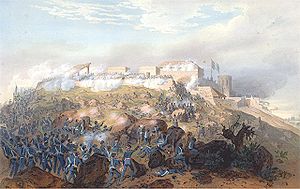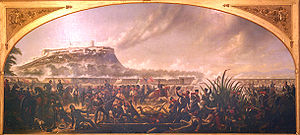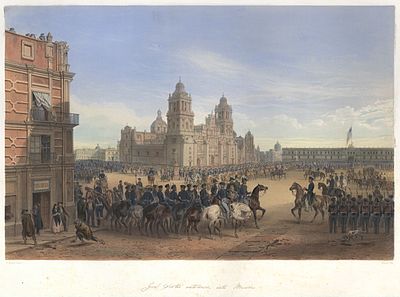- Battle for Mexico City
-
Mexico City Campaign Part of the Mexican-American War 
The American assault on Chapultepec Castle.Date September 8–15 1847 Location Mexico City, D.F. Result Decisive United States victory Belligerents  United States
United States Mexico
MexicoCommanders and leaders  Winfield Scott
Winfield Scott Antonio López de Santa Anna
Antonio López de Santa AnnaStrength 7,157 16,000 Casualties and losses ~1,651 killed or wounded[1] ~2,323 killed or wounded,
~3,000 captured [1]Mexico City Campaign- 1st Veracruz
- 2nd Veracruz
- Cerro Gordo
- Contreras
- Churubusco
- Mexico City
- Molino del Rey
- Chapultapec
- Belén and San Cosme Gates
- Thornton Affair
- Fort Texas
- Palo Alto
- Resaca de la Palma
- Olompali
- Monterey
- Santa Fe
- Monterrey
- 1st Tabasco
- Los Angeles
- Chino
- Dominguez Rancho
- Natividad
- San Pasqual
- Tucson
- El Brazito
- Rio San Gabriel
- La Mesa
- Cañada
- 1st Mora
- Embudo Pass
- 2nd Mora
- Pueblo de Taos
- Buena Vista
- Sacramento River
- 1st Veracruz
- 2nd Veracruz
- Cerro Gordo
- 1st Tuxpan
- Red River Canyon
- 2nd Tuxpan
- 2nd Tabasco
- 3rd Tuxpan
- Las Vegas
- Cienega Creek
- Contreras
- Churubusco
- Molino del Rey
- Chapultepec
- Mexico City
- Puebla
- Mulege
- Huamantla
- Atlixco
- Punta Sombrero
- 1st La Paz
- 1st San Jose del Cabo
- 2nd La Paz
- 2nd San Jose del Cabo
- Santa Cruz de Rosales
The Battle for Mexico City refers to the series of engagements from September 8 to September 15, 1847, in the general vicinity of Mexico City during the Mexican-American War. Included are major actions at the battles of Molino del Rey and Chapultepec, culminating with the fall of Mexico City.
Contents
Background
The major objective of American operations in central Mexico had been the capture of Mexico City. After capturing the port of Veracruz in March, General Winfield Scott was able to secure a base and move inland and defeat a large Mexican force at the Battle of Cerro Gordo. After routing the Mexicans at the Battle of Churubusco, Scott's army was only five miles (8 km) away from its objective of Mexico City.
Although defeated at Cerro Gordo and Churubusco, General Santa Anna's army remained intact and totally outnumbered Scott.
Order of battle
United States
US Army - MG Winfield Scott
Division Brigade Regiments and Others 1st Division
MG William J. Worth1st Brigade
K-17, W-69, M-8 = 94
Brevet BG John Garland- 2nd Artillery - Cpt. Horace Brooks
- 3rd Artillery - Maj. Robert C. Buchanan
- 4th Infantry - Maj. Francis Lee
- Duncan's Battery - Col. James H. Duncan
2nd Brigade
K-8, W-48, M-0 = 56
Brevet BG Newman S. Clarke- 5th US Infantry
- 6th US Infantry - Lt Edward Johnson
- 8th US Infantry[1] - Maj Montgomery
2nd Division
MG David E. Twiggs1st Brigade
K-24, W-137, M-6 = 167
Brevet BG Persifor F. Smith- 1st US Artillery
- 3rd US Infantry
- Taylor's Battery
2nd Brigade
K-18, W-80, M-4 = 102
Brevet BG Bennet Riley- 2nd US Infantry - Lt Frederick Steele
- 7th US Infantry - Ltc Dixon S. Miles
- 4th US Artillery
3rd Division
MG Gideon Pillow (w)1st Brigade
K-12, W-41, M-1 = 54- 9th US Infantry - Col Truman B. Ransom (k)
- 12th US Infantry
- 15th US Infantry - Col George Washington Morgan
- Magruder's Battery
2nd Brigade
K-8, W-69, M-9 = 89
BG George Cadwallader- 11th US Infantry (attached to 14th Infantry)
- 14th US Infantry - Col William Trousdale (w)
- Voltigeurs - Col Timothy Patrick Andrews, Ltc Joseph E. Johnston
4th Division
MG John A. Quitman1st Brigade
K-35, W-245, M-0 = 280- 2nd New York Infantry - Col W.B. Burnett
- 2nd Pennsylvania Infantry - Ltc John W. Geary (w)
- South Carolina Palmetto Infantry - Ltc James P. Dickinson
- Steptoe's Battery
Marines
K-7, W-24, M-0 = 31
Ltc Samuel E. Watson- Storming Party - Lt Levi Twiggs (w)
- Storming Party - Cpt John Reynolds
- Storming Party - Cpt George S. Terrett
Dragoons
Dragoon Brigade
Brevet BG William S. Harney- 1st US Dragoons
- 2nd US Dragoons - Brevet Col Edwin V. Sumner
- 3rd US Dragoons
- 4th US Artillery
Mexico
7 August 1847—20,210 men and 104 Guns acs
Mexican Army General Antonio López de Santa Anna
Chief of Artillery: General Martin Carrera
Chief of Engineers: General Ignacio Mora y Villamil- Army of the East General Manuel Lombardini
- 1st Brigade General Andres Terres (1st Activos, Lakes and 2nd Light Battalions)
- 2nd Brigade General Mariano Martinez (Morelia Activos, Invalids Corps)
- 3rd Brigade General Joaquin Rangel (Mixto Sta Anna, Morelia National Guards)
- 4th Brigade General Francisco Perez (1st, 3rd & 4th Light, 11th Infantry)
- 5th Brigade General Antonio Leon (Oajaca & Queretaro Activos, 10th Infantry, Queretaro & Mina National Guards)
- 6th Brigade General Pedro María de Anaya (Independencia, Bravos, Victoria & Hidalgo National Guards)
- 7th Brigade Col. Anastasio Zerecero (Acapulco, parts Tlapa & Libertad pickets)
- Army of the North General Gabriel Valencia 3,000 Infantry, 1,000 Cavalry & 500 Artillery
- Vanguard Brigade General Francisco Mejia (Fijo de Mexico, Potosi Activos, 7th Cavalry)
- Centre Brigade General Anastasio Parrodi (10th and 11th Infantry, Tampico Coast Guards, Queretaro, Celaya and Guanajuato Activos, Celaya Auxiliary)
- Reserve Brigade General Mariano Salas (Engineers, Mixto Santa Anna, Aguascalientes Activos, 2nd, 3rd & 8th Cavalry, Guanajuato Cavalry)
- Army of the South General Juan Álvarez 2,762 Cavalry
- Cavalry Division
Alcaraz, Ramon "Apuntes para la historia de la guerra entre Mexico...†
Battles
Molino del Rey
Main article: Battle of Molino del ReyOn September 8, the fight for Mexico City began. Scott believed that a cannon foundry was located at the Molino del Rey, the King's Mill, located just over 2 miles (3 km) outside the city. Scott sent the 1st Division under William J. Worth to seize and destroy the foundry. Worth wished to include Chapultepec Castle in his attack, and when Scott refused, a bitter rivalry began between Scott and Worth. In the ensuing battle, both sides suffered heavy casualties, and Worth drove the Mexicans from the mill, separating them from the forces at Chapultepec. The battle produced no significant military gains for the U.S.
Chapultepec
 James Walker, Storming of Chapultepec (1847)
James Walker, Storming of Chapultepec (1847) Main article: Battle of Chapultepec
Main article: Battle of ChapultepecThe main assault on the city came a few days later on September 12. Mexico City was guarded in part by Chapultepec Castle, which was being used as a military academy. Scott preceded infantry assault with an all day artillery barrage on September 12. The next day, September 13, the 4th Division, under John A. Quitman, spearheaded the attack against Chapultepec and carried the castle. Future Confederate generals George E. Pickett and James Longstreet participated in the attack. Serving in the Mexican defense were the cadets later immortalized as Los Niños Héroes (the "Boy Heroes"). The Mexican forces fell back from Chapultepec and retreated within the city.
Attacks on the Belén and San Cosme Gates
Quitman's Division made its way down the Belén Causeway towards the Belén Gate, defended by General Terres & Colonel Garay with 3 guns, while Worth's Division further to the north made its way up La Verónica Causeway towards the San Cosme Gate, defended by General Rangel's Infantry Brigade (Granaderos Battalion, 1st Light, part 3d Light under Lt.Col. Echeagaray) with 3 guns and howitzers. Quitman was merely supposed to make a feint towards the city, but he pushed forward his whole division and broke through the defenses. Santa Anna arrived at the Belén Gate in a fury and relieved the front commander. Worth's Division in the meantime had a slow start against the Mexicans after beating off a Mexican cavalry attack. When he reached San Cosme, he found its defenses ill prepared, but the Mexicans defending it put up a good fight before falling back. Ulysses S. Grant found his way into the action along the causeway on Worth's front and helped in hoisting a cannon into the belltower of a nearby church. From this spot Grant fired into the defenders below. When the fighting subsided on all fronts, both gates had fallen and the Mexicans had withdrawn into the city. Other gates defended were: San Antonio by General M. Martínez with 10 guns; Nino Perdido by the National Guards and 2 guns; and San Lázaro, Guadalupe and Villejo, which were defended by small infantry detachments.
Fall of Mexico City


This Carl Nebel painting depicts Winfield Scott entering the Plaza de la Constitución; the Metropolitan Cathedral is in the background. The Junta (Gens. Alcorta, Carrera, Lombardini & Fran. Pérez) had withdrawn their army: 14 Guns, 4,000 Cavalry (Quijano & Andrade Brigades), and 5,000 Infantry (Gov. Olaguibel: Toluca National Guards, Cmdte. Arroyo: Lagos, Iturbide, & Tula Battalions, Gen. Martínez: various pickets, and Gen. Pérez: 11th Infantry & remnants of Light Regts.) from the city during the night, and the U.S. forces, expecting another assault, found the city undefended. Worth and Quitman advanced cautiously. Quitman sent Lieutenant Pierre Beauregard to arrange the surrender of the ciudadela. Beauregard and Mansfield Lovell were met by a Mexican officer who asked for a receipt for the captured ciudadela.( 15 Guns) Beauregard exclaimed that "we give receipts at the point of their swords". Scott gave the honor of formally entering the city to Quitman's Division. The conquering army was less than impressing, the troops wore ragged and bloodstained uniforms and Quitman only had on one shoe when he marched into the city. Worth personally took down the flag flying over the National Palace, and a U.S. Marine hoisted the U.S. flag in its place. Quitman marched into the Zócalo plaza in the center of the city in front of the National Palace where the formal surrender took place. As Worth's division entered the city the leading unit was John Garland's brigade.
Stragglers from the Mexican army left in the city after Santa Anna's withdrawal climbed to the roofs of houses and began shooting at the American soldiers. General Garland was hit in the chest with the first shot and fell severely wounded. Before he evacuated, Santa Anna released 30,000 prisoners into the streets of the city, and these rooftop shots provoked the prisoners into similar acts. Worth did manage to get the sniping under control. William S. Harney's dragoons escorted General Scott into the city wearing his immaculate dress uniform and was greeted by patriotic music. Scott appointed the politically savvy Quitman as military governor, becoming the only American to ever rule from the National Palace.
Casualties
September 8
- U.S. 116 killed, 665 wounded, 18 missing, 789 total
- Mexican 2,700 total
September 12–15
- U.S. 130 killed, 703 wounded, 29 missing, 862 total
- Mexican 1,800 killed and wounded, 823 captured, 2,623 total
Totals
- U.S. 1,651
- Mexican 5,323
See also
- Battle of Molino del Rey
- Battles of the Mexican-American War
- Marines' hymn
- Saint Patrick's Battalion
Notes
^ Lieutenant Colonel James S. McIntosh temporarily commanded Clarke's brigade at Molino del Rey; Clarke returned to command after McIntosh was killed during the fighting.
References
- Nevin, David; editor, The Mexican War (1978)
- Bauer, K. Jack, "The Mexican-American War 1846–48"
- Brooks, N. C., "A Complete History Of The Mexican War: Its Causes, Conduct And Consequences" (1849)
External links
Categories:- 1847 in Mexico
- Battles of the Mexican–American War
- History of Mexico City
- Mexico City Campaign
- United States Marine Corps in the 18th and 19th centuries
Wikimedia Foundation. 2010.
